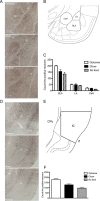Incentive memory: evidence the basolateral amygdala encodes and the insular cortex retrieves outcome values to guide choice between goal-directed actions
- PMID: 23678118
- PMCID: PMC3717368
- DOI: 10.1523/JNEUROSCI.5071-12.2013
Incentive memory: evidence the basolateral amygdala encodes and the insular cortex retrieves outcome values to guide choice between goal-directed actions
Abstract
Choice between goal-directed actions is determined by the relative value of their consequences. Such values are encoded during incentive learning and later retrieved to guide performance. Although the basolateral amygdala (BLA) and the gustatory region of insular cortex (IC) have been implicated in these processes, their relative contribution is still a matter of debate. Here we assessed whether these structures interact during incentive learning and retrieval to guide choice. In these experiments, rats were trained on two actions for distinct outcomes after which one of the two outcomes was devalued by specific satiety immediately before a choice extinction test. We first confirmed that, relative to appropriate controls, outcome devaluation recruited both the BLA and IC based on activation of the immediate early gene Arc; however, we found that infusion of the NMDAr antagonist ifenprodil into the BLA only abolished outcome devaluation when given before devaluation. In contrast, ifenprodil infusion into the IC was effective whether made before devaluation or test. We hypothesized that the BLA encodes and the IC retrieves incentive value for choice and, to test this, developed a novel sequential disconnection procedure. Blocking NMDAr activation unilaterally in the BLA before devaluation and then contralaterally in the IC before test abolished selective devaluation. In contrast, reversing the order of these infusions left devaluation intact. These results confirm that the BLA and IC form a circuit mediating the encoding and retrieval of outcome values, with the BLA encoding and the IC retrieving such values to guide choice.
Figures






References
-
- Balleine BW. Incentive processes in instrumental conditioning. In: Mowrer R, Klein S, editors. Handbook of contemporary learning theories. Hillsdale, NJ: LEA; 2001. pp. 307–366.
-
- Balleine BW. Sensation, incentive learning, and the motivational control of goal-directed action. In: Gottfried JA, editor. Neurobiology of sensation and reward. Boca Raton, FL: CRC; 2004. chapter 13. - PubMed
Publication types
MeSH terms
Substances
Grants and funding
LinkOut - more resources
Full Text Sources
Other Literature Sources
Medical
